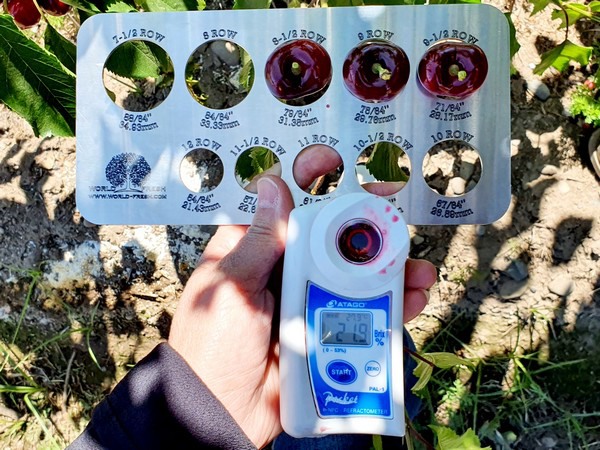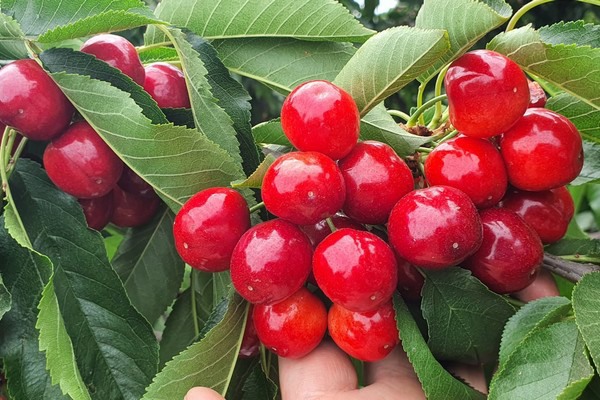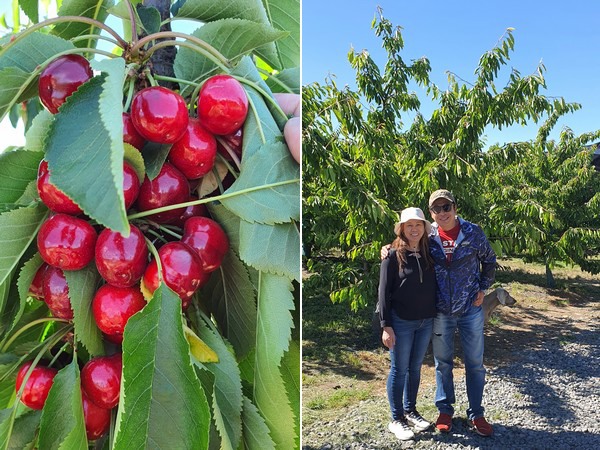This past Tuesday, the Chilean cherry harvest kicked off for Sutherland, S.A. “We are off to a late start this year due to unseasonably cool weather in our growing region Graneros,” says Ricky Chong, the company’s CEO.
“However, after inspecting orchards for the last few days, we are seeing a good fruit set on the trees and expect to ship higher volumes this season compared to last year.” This is in line with the country’s overall cherry volume that is expected to be up 12 percent from the 2020-2021 season. In addition to quantity, expectations of quality are high as well. “Fruit quality is excellent,” said Chong. “It is clean looking fruit with good size profiles, high brix levels as well as good firmness.”
 Showing different sizes and a Brix level of 21.9.
Showing different sizes and a Brix level of 21.9.
Two decades of Chilean cherry experience
Sutherland has been involved in growing cherries in Chile for the past two decades. “We first visited Chile about 20 years ago on a fact-finding mission for the Canadian government,” said Chong. “Many cherry orchards and packing facilities were visited during that trip and the Sutherland team fell in love with the people and the country. “During that visit, an opportunity presented itself to develop new cherry orchards, and it was a quick decision for us to invest in Chile.” In addition, the company also works with a few growers and packing sheds in the Rancagua & Curico growing regions.
Asian customers pay premium
Chilean cherries are popular all over the world, but the large majority are shipped to China. According to the Chilean Fruit Exporters Association, 91 percent were exported to the Chinese market last year. “At Sutherland, we have spent the last five years strengthening our business in Southeast Asia, South Korea, Japan, Europe, and the Middle East.” Asian customers prefer hard, crunchy cherries and are usually prepared to pay a premium. Cherries in Chile are grown to meet the expectations of the Asian customers, but not all cherries meet the firmness criteria. “Fortunately, in other parts of the world, firmness is not as important, and consumers prefer a dark, sweet cherry with good flavor.”

Higher costs and more risks
During the campaign, Sutherland works in the fields and the packing sheds. “Our QC inspectors oversee quality at every stage of the process and our logistics team takes over managing all air, sea, and truck shipments to our clients’ doors no matter where they are based in the world.” Chong expects a strong season but anticipates returns to be affected by significant price increases. “Production costs including labor, packaging, and transportation rates are significantly higher this season. Sea rates have increased 100-200 percent.” In addition, the risks have increased due to a shortage of vessels, containers, postponements, cancellations, and delays at ports. “We still need to sell our fruit and will have to absorb many of the additional costs and take more risks this season,” Chong commented.
With representation across the globe, Sutherland is able to offer cherries 8-10 months out of the year. In addition to Chile, the company is involved in the cherry deals in California, Washington, Canada, Spain, Tasmania, and China.

Kim Hoang, Director of Sales with Sutherland and Marcus Chow, Director of Sales for Gold Anda Chile.
 For more information:
For more information:
Ricky Chong
Sutherland S.A. Produce, Inc.
Ph: +1 (403) 616-1977
[email protected]
www.cherries.global
